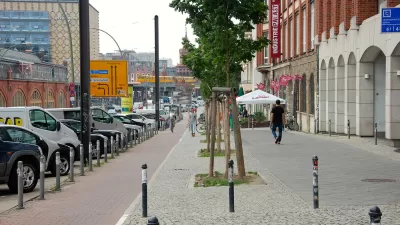Charles Marohn derides the conflicted approach to creating "Safe Routes to Schools" in the United States. With new data linking transport to school to educational outcomes, is it time to rethink the federal government's popular program?
While he believes the goals of the Safe Routes to Schools program are laudable, Marohn decries an approach that invests millions in retrofitting schools and their surroundings to increase walkability and bikeability, but spends billions on constructing new schools in remote, auto-centric areas. "We spend tens of millions each year (a ridiculously small sum given the size of the task) in an attempt to retrofit schools to be walkable. Would it not be far more effective to simply locate new schools in areas that are already 'safe'?" asks Marohn. "Of course it would be, so why is nobody advocating for this?"
"According to the American Clearinghouse on Educational Facilities, there was $8.7 billion spent constructing new schools in 2010. That does not include renovations ($2.8 billion) or additions ($3.1 billion). That's an enormous number of new schools. The amount that will someday be spent retrofitting them to be 'safe' is paltry in comparison."
In light of a Danish study released late last year that found that "kids who cycled or walked to school...performed measurably better on tasks demanding concentration," Marohn's harangue is worth considering.
FULL STORY: How about Schools on Safe Routes?

Maui's Vacation Rental Debate Turns Ugly
Verbal attacks, misinformation campaigns and fistfights plague a high-stakes debate to convert thousands of vacation rentals into long-term housing.

Planetizen Federal Action Tracker
A weekly monitor of how Trump’s orders and actions are impacting planners and planning in America.

In Urban Planning, AI Prompting Could be the New Design Thinking
Creativity has long been key to great urban design. What if we see AI as our new creative partner?

Portland Raises Parking Fees to Pay for Street Maintenance
The city is struggling to bridge a massive budget gap at the Bureau of Transportation, which largely depleted its reserves during the Civd-19 pandemic.

Spokane Mayor Introduces Housing Reforms Package
Mayor Lisa Brown’s proposals include deferring or waiving some development fees to encourage more affordable housing development.

Houston Mayor Kills Another Bike Lane
The mayor rejected a proposed bike lane in the Montrose district in keeping with his pledge to maintain car lanes.
Urban Design for Planners 1: Software Tools
This six-course series explores essential urban design concepts using open source software and equips planners with the tools they need to participate fully in the urban design process.
Planning for Universal Design
Learn the tools for implementing Universal Design in planning regulations.
Gallatin County Department of Planning & Community Development
Heyer Gruel & Associates PA
JM Goldson LLC
City of Camden Redevelopment Agency
City of Astoria
Transportation Research & Education Center (TREC) at Portland State University
Jefferson Parish Government
Camden Redevelopment Agency
City of Claremont




























